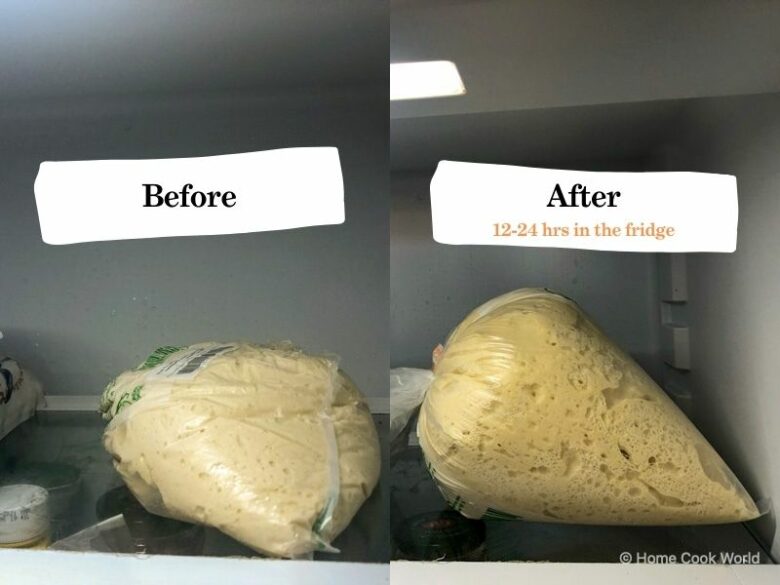When you’re craving homemade pizza but don’t want to make dough from scratch, you can save yourself the mess of mixing and kneading by buying frozen pizza dough from the store.
Should you let it rise before baking?
The labels on most frozen doughs are surprisingly vague about this. I guess most brands haven’t thought about what happens after you’ve taken their products off the freezer shelves.
To make a light and airy pizza from frozen dough, let the dough rise for a few hours at room temperature or 1-3 days in your fridge.
It’s rare to see store-bought dough that’s been given the time to rise properly.
And no wonder! If you were a manufacturer of frozen dough, which would you prefer? To make and sell fewer well-risen batches of dough per day or to freeze them early and soon and sell as many as possible?
Readers who want an airy crust with a rich flavor (and who doesn’t?) should take the time to correct this mistake in their home kitchens.
The good news is that leavening frozen pizza dough is just as easy as putting it in your cart in the first place. You don’t have to do anything but put the dough in a large bowl covered with plastic wrap, store it in the refrigerator, and leave it there for 1 to 3 days.
As a general rule of thumb, the longer the thaw, the airier and tastier the dough. Try keeping it in your fridge for a few days, and I guarantee you that your pizza will come out looking, smelling, and tasting like that of a Neapolitan-style pizzeria.
Just notice the difference:

How Dough Rises (And Why It Matters)
If you’re not that much into baking, this whole process probably seems a little strange to you. So, in the following few paragraphs, I’m going to show you why (and how) it works.
In its simplest form, pizza dough consists of four ingredients: flour, water, yeast, salt.
The technique for making dough is also simple. You mix the ingredients, knead the dough, and rest it for enough time, allowing it to rise before baking.
Mixing incorporates the ingredients together. Without it, the salt and yeast won’t be distributed evenly inside the dough ball, resulting in a poor rise (or no rise at all) and an uneven flavor.
Kneading adds strength and elasticity to the dough by developing the strands of protein contained in the flour (the protein in wheat flour is called “gluten”). This makes it workable into any shape and allows it to hold on to the air bubbles produced during the rise.
During the rise, the yeast cells start feeding on the carbohydrates (sugars and starches) in the dough, farting out carbon dioxide (CO2) bubbles and ethanol (C2H5OH) as a byproduct. The dough is dense, so the air bubbles get trapped and build up inside it—making it rise. The ethanol gives it a richer flavor.
Yeast thrives on humidity and warmth, which is why it makes dough rise the fastest in a humid house at room temperature. The colder the air, the slower the rise. Yeast, after all, is a living thing; you wouldn’t be very productive out in the cold either!
Professional bakers and food experts call this process “fermentation,” and it’s the same one that brewers use to turn wheat into beer. Fermentation is influenced by mainly two factors: humidity and temperature.
Freezing halts all biological processes. In other words, when you freeze dough, you put its fermentation and leavening on pause. The refrigerator, on the other hand, slows down the fermentation of the yeast, but doesn’t halt it.
So don’t hesitate to keep frozen pizza dough in your fridge for a few days. I’ve chatted with home cooks who like to keep theirs for as long as a week. Imagine the complexity of flavor!
Here’s a photo from a pizza I made today with dough that had rested for 2 1/2 days:

Can You Leave Frozen Pizza Dough Out?
Suppose you’re in a hurry—and you don’t have several days at your disposal to perfect a frozen dough. Can you leave it out on the counter and come back to it in a few hours?
Yes, you can leave frozen pizza dough out to thaw and rise at room temperature.
If the dough hasn’t been thawed, take it out of the freezer in the morning, transfer it to a large bowl covered tightly with plastic wrap, and bake with it in the late afternoon or early evening.
If you already thawed the dough overnight, take it out of the fridge and rest it for 15-30 minutes in bowl covered with plastic wrap, allowing it to get up to room temperature.
Don’t try to shape the dough as soon as you’ve taken it out of the fridge. Its cold internal temperature will make it hard to work with and cause it to retract shortly after stretching.
In Conclusion
The most common question that home cooks have about making pizza with store-bought dough is whether or not it needs to rise. Unfortunately, the instructions on the back of the label won’t say much on the topic. Sometimes, they’ll even mislead you to do the wrong thing.
While you can make a quick pizza by not letting the dough rise, your pie will come out dense, chewy, and challenging for your body to digest. For a light and airy pizza, thaw the frozen dough for 1-2 days in your fridge before shaping.
Yes, this technique takes time and patience. But try it once, and the chances are you’ll never go back to your old ways. How did this work out for you? Let me know in the comments below!
